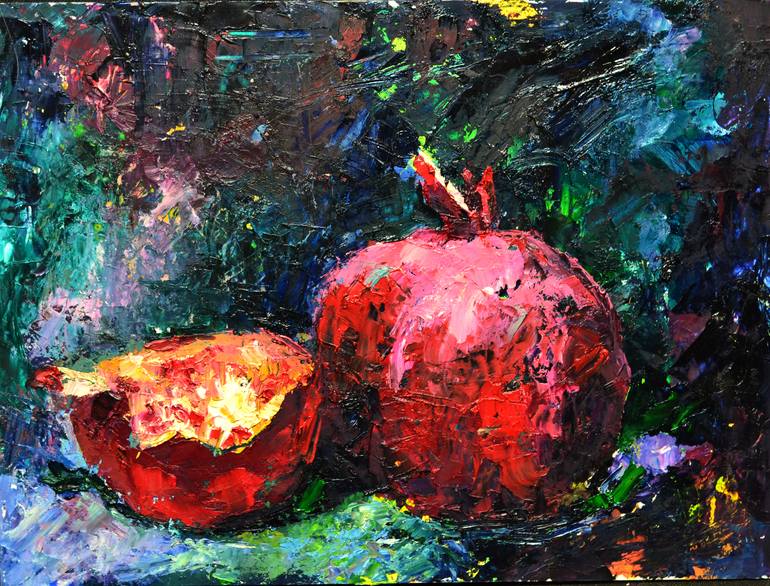







VIEW IN MY ROOM
Pomegranate Painting
Ukraine
Painting, Oil on Canvas
Size: 15.7 W x 11.8 H x 0.4 D in
Ships in a Box
About The Artwork
Pomegranate is significant in the culture of the Greeks, Phoenicians, Persians, Armenians, in the Christian tradition. The Phoenicians, he was an attribute of the sun god, a symbol of life. In Persia - a symbol of higher power. In Greece - an attribute of Hera, the goddess of vows and marriage. And, of course, an attribute of Demeter - the goddess of eternal rebirth and fertility. There was a Greek legend that the first pomegranate tree was planted by the goddess Aphrodite, and the golden pomegranate on the island of Cyprus became a symbol of love and bondage. The species name malum granatum means granular apple. According to the structure, it represents a multitude of grains, united under one dense shell, and gives an amazing example of combining the plural into a single whole, giving rise to a new quality - the undivided fruit of the “apple”.He talks about how to regain inner harmony, joy, integrity, harmony and a sense of unity - how to regain, and nothing else. The symbolism of grains in the Egyptian tradition is very interesting: with grains a person came to the ground, germinated them and left with new grains in his heart, which was then weighed on the scales of Osiris. The seeds, which are originally part of the Whole, the One, the Great, are given to us for the preservation and transformation of ourselves. The symbol of the pomegranate was associated with the ancient mysteries. And the mysteries always raised man above the earth, immersed in a space of a different scale - the space of great Harmony and Eternity. In the Greek Mysteries, pomegranate grains were eaten by young Persephone, thus escaping from great oblivion, and returned to the world not as a young and naive girl, but as a wise woman, the true daughter of her Great Mother. It was the pomegranate grains that helped her to remain alive and unharmed in the realm of the dead, and then come out into the light again, to be reborn for life. So amazing fruit appears before us as a pledge of immortality. And we are still worried about questions of loneliness, love, harmony, the answers to which we are looking for in our favorite books, films, articles - “One Hundred Years of Solitude”, “In Search of Lost Unity” ... Which ones will you add? And over all this, the majestic image of the goddess shimmers, stretching to us the opened garnet - the king of fruits, the symbol of rebirth, immortality, and life. Many ancient peoples associated with a pomegranate hope of resurrection and immortality. All traditional world religions assign a special place to the pomegranate symbol. In Buddhism, pomegranate is one of the blessed fruits, along with citrus and peach. In Islam, it was considered a symbol of moral purification, a fruit that grew in Paradise. In China, it symbolizes abundance, fertility, and a happy future. It is also mentioned in a number of holy books, including the Bible, where it appears as a beauty image, as well as a symbol of the unity of the world. In many picturesque canvases of the Middle Ages and the Renaissance, the baby Jesus holds in his hand a pomegranate - a gift brought by Christ to humanity, the gift of eternal life. According to one of the legends, the ark of Noah, moored on the top of Mount Ararat, was lit by garnet.
Details & Dimensions
Multi-paneled Painting:Oil on Canvas
Original:One-of-a-kind Artwork
Size:15.7 W x 11.8 H x 0.4 D in
Number of Panels:2
Frame:Black
Ready to Hang:Not applicable
Packaging:Ships in a Box
Shipping & Returns
Delivery Time:Typically 5-7 business days for domestic shipments, 10-14 business days for international shipments.
Handling:Ships in a box. Artists are responsible for packaging and adhering to Saatchi Art’s packaging guidelines.
Ships From:Ukraine.
Customs:Shipments from Ukraine may experience delays due to country's regulations for exporting valuable artworks.
Have additional questions?
Please visit our help section or contact us.
Ukraine
Was born in 1992 in Kiev (Ukraine) Professional artist of monumental art. Engaged in painting (oil, acrylic, tempera), artistic enamel (picturesque, cloisonne, stained glass), mosaic, stained glass, sculpture, tapestry. Since 2007, art works are presented at exhibitions, the winner of international competitions, participant of international symposiums, festivals.
Thousands Of Five-Star Reviews
We deliver world-class customer service to all of our art buyers.
Global Selection
Explore an unparalleled artwork selection by artists from around the world.
Satisfaction Guaranteed
Our 14-day satisfaction guarantee allows you to buy with confidence.
Support An Artist With Every Purchase
We pay our artists more on every sale than other galleries.
Need More Help?